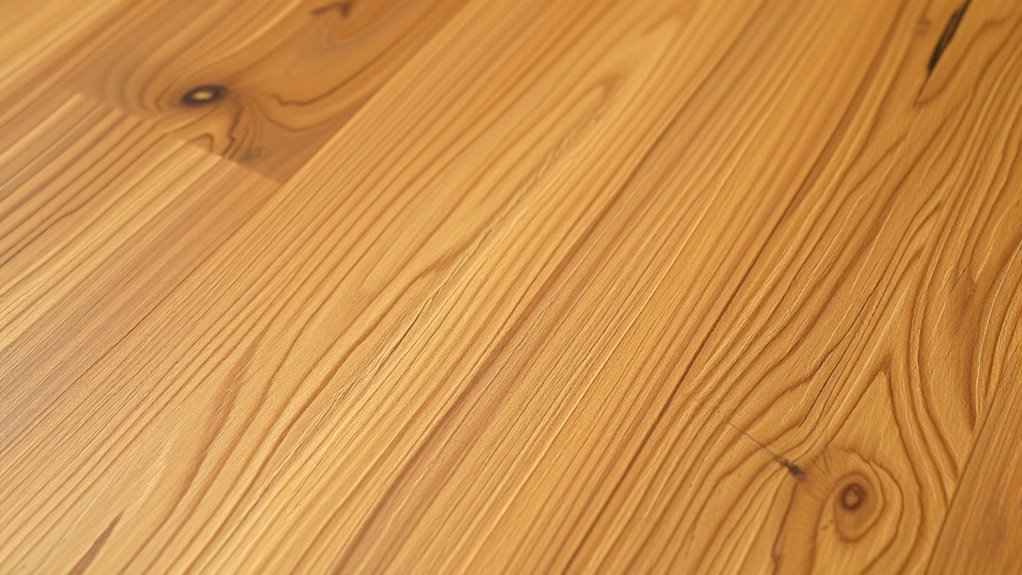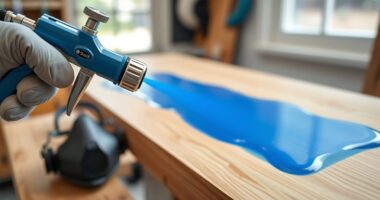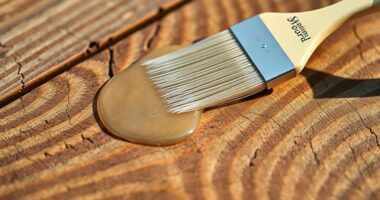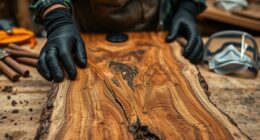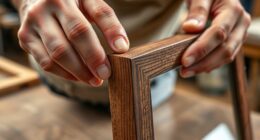To match stains effectively, you need to understand undertones—warm, cool, or neutral—and how they complement each other. Recognize the natural color and grain of your wood species, like cherry’s reddish warmth or oak’s neutral tones, since these influence how stains appear. Test stains on small areas before committing. Paying attention to undertones and wood characteristics guarantees a harmonious finish that lasts. Keep reading to discover more tips for perfect stain matching.
Key Takeaways
- Identify wood species to understand its natural color and how it influences stain appearance.
- Recognize warm, cool, and neutral undertones in both wood and stains for better matching.
- Test stains on small areas to observe how the wood’s undertones interact with the color.
- Consider how the wood’s grain and inherent hue affect the final stained finish.
- Match stain undertones to the wood’s natural characteristics for a cohesive and harmonious look.

Have you ever struggled to find the right stain match for your fabric or upholstery? It’s a common challenge, especially when trying to achieve a seamless look that blends perfectly with your existing furniture or project. One of the key factors in successful stain matching is understanding undertones—those subtle hints of color that influence the overall appearance. Recognizing whether a wood or fabric has warm, cool, or neutral undertones helps you select a stain that complements rather than clashes. This attention to undertones ensures color consistency, so your final result looks cohesive and polished. Without it, you risk mismatched finishes that stand out for all the wrong reasons.
When you’re matching stains, it’s also crucial to consider the specific wood species or fabric material. Different woods, like oak, cherry, or maple, have unique grain patterns and inherent color variations. These differences can affect how a stain appears once applied. For example, cherry wood tends to have warm, reddish undertones that can intensify with darker stains, while oak often has more neutral or cooler tones. Knowing the wood’s natural color helps you choose a stain that enhances its beauty without overpowering it. Similarly, fabrics can have underlying hues that influence how stains or dyes take, so testing on a small, inconspicuous area is always a smart move. Understanding wood species and their characteristics can make a significant difference in achieving a professional finish.
Color consistency is essential for professional-looking results. When matching stains, you want the tone to stay uniform across all surfaces. Achieving this requires mixing stain batches carefully and applying multiple thin coats rather than a single thick layer. This approach not only ensures even color but also helps you maintain finish protection. A consistent stain layer safeguards the material against future wear and damage, preserving your work for years to come. Over-application or uneven layers can lead to blotchiness, which ruins the look and diminishes the overall quality of your project.
Additionally, keep in mind that different stains and finishes can alter the appearance over time. Some finishes may deepen or change the hue slightly, so it’s wise to test your stain with the topcoat before committing to the entire piece. This step ensures that the final color stays true and your finish remains protected. The goal is to create a harmonious look that not only matches visually but also endures the test of time. By understanding undertones, wood species, and the importance of finish protection, you can confidently tackle stain matching and achieve professional, consistent results every time.
Frequently Asked Questions
How Do Natural Lighting Conditions Affect Stain Color Perception?
Natural lighting conditions substantially impact your perception of stain color. Lighting variability throughout the day can make colors appear warmer, cooler, or more muted than they truly are. You might notice differences in color perception depending on whether it’s direct sunlight or diffuse daylight. To guarantee accurate color matching, observe your stained wood under various natural lighting conditions, and consider how changing light affects the overall look.
Can Stain Matching Techniques Be Used on Reclaimed or Aged Wood?
Imagine the character of reclaimed or aged wood, with its rich history etched into every grain. You can definitely use stain matching techniques on it. The key is to understand its unique undertones and imperfections. By carefully testing your stain on small, inconspicuous areas first, you can achieve a harmonious look that enhances its aged beauty, giving your project a personalized touch that respects its history.
What Tools Are Best for Testing Stain Colors on Wood?
You should use color matching tools like a small gel stain or a test board for sample testing. These tools help you see how the stain interacts with your wood before committing. Keep a color chart or digital color-matching app handy to compare shades accurately. By testing different stain colors on scrap pieces or hidden areas, you guarantee a perfect match, saving time and avoiding costly mistakes.
How Do Different Finishes Impact the Appearance of Stained Wood?
Think of finishes as the wardrobe for your stained wood—each one changes how it looks. A high-gloss finish reflects more light, making colors pop, while a matte finish softens and mutes tones. Finish sheen influences the depth of stain opacity, enhancing or diminishing color visibility. So, your choice of finish can turn a simple stain into a stunning statement or a subtle background, shaping your project’s final character.
Are There Eco-Friendly Stain Options That Still Provide Accurate Color Matching?
Yes, there are eco-friendly stains that offer accurate color matching. Look for eco-friendly stains made from sustainable ingredients like plant-based oils and natural dyes. These products provide sustainable coloring without harmful chemicals, so you can achieve the desired color while protecting the environment. Always check for certifications like Green Seal or FSC to verify you’re choosing truly sustainable options that deliver professional results.
Conclusion
Now you’re armed with the secrets of stain matching, ready to conquer any wood project like a true master. Reading undertones and identifying wood species isn’t just a skill—it’s a superpower that transforms dull, mismatched pieces into stunning masterpieces. With just a little practice, you’ll be able to make every project look like it was crafted by the woodworking gods themselves. Get out there and turn ordinary wood into extraordinary art—your perfect finish awaits!
